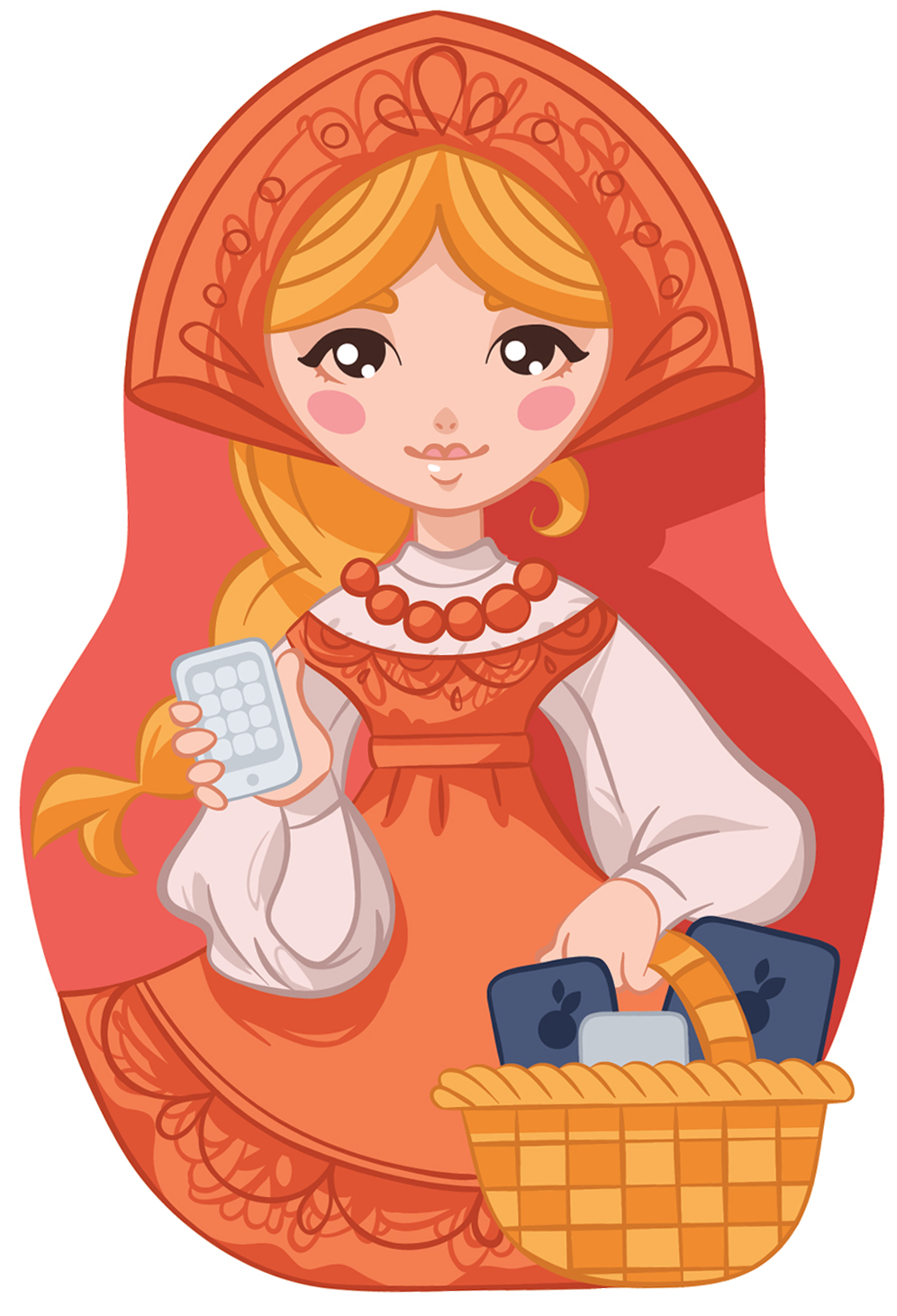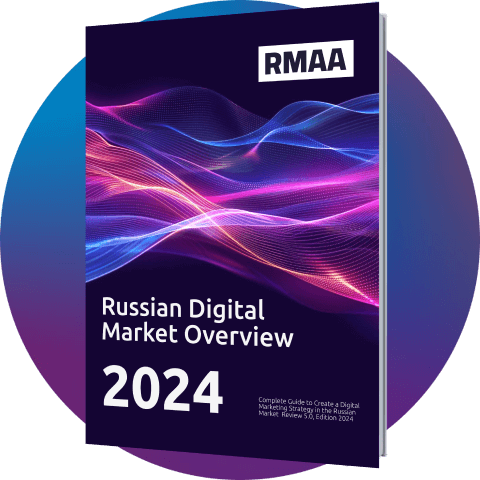Blog about successful marketing strategies in russia
Features of Social Media Marketing in Russia. Which social network to choose for brand promotion?


DIGITAL MARKETING
Share this Post
Modern Russian social networks are becoming full-fledged aggregator services, offering users a multitude of functions and opportunities. Each site has its own audience. To run effective advertising, you need to know where your content will produce the best results.
In terms of influencer marketing, there were 51.61 million Russian-speaking authors on social networks at the beginning of 2024. Some resources are gaining popularity, while others are losing users. VKontakte is the clear leader in the number of content creators in Russia, with 24.88 million authors publishing posts every month. In the first months of this year, 641 thousand people came to the social network. In contrast, Instagram has already lost 3.89 million active users.
Telegram's audience has grown significantly in recent years, with a "cosmic" leap of +18 million people in just two years. On May 17, 2024, 947 thousand channels were recorded in the messenger, and the total number of users reached 4,036,760,000 people. Also, there are the old Odnoklassniki and YouTube, long familiar to Russians of different ages.
Let's dive deep into Russian social media and explore how brands can make the most of it.
Telegram
Telegram is the most popular service in Russia in 2023, second only to WhatsApp. Surveys show that 91% of the country's residents use the messenger, with most of them over 25 years old.
Telegram is and always will be a messenger. Its main function is to send and receive messages.

SMM approach for Telegram
The first thing a brand needs to do is to start its channel where expert content can be shared with the audience (potential clients). It is important to remember that promoting a Telegram channel is not a quick process. Therefore, it is essential to develop a long-term strategy from the outset.
Express instructions on how to launch a Telegram channel:
- Analyze the target audience.
- Clearly define the mission and main ideas that the brand will broadcast to customers.
- Choose topics and formats. Alternate between several types of publications to keep users engaged.
- Create engaging content and interactivity. This is the key to audience engagement. It is therefore essential to approach the content of the channel responsibly.
- Promotion. The first campaign will assess the channel's readiness for further advertising. It is crucial to test formats (seeding in channels, paid socials, partnership with bloggers), creatives, launch time, etc. at this stage.
- Work on reader retention. Monitor the market closely and create content that will be engaging to users right now. Don't forget to encourage engagement through comments.
- Prepare the next advertising campaign. This requires a more in-depth analysis of competitors, a strategy, and improvements to the channel.
- Analyze the results and make the necessary adjustments.
Promotion on Telegram will be most effective for those niches where you can generate interesting, useful, or news content. Since there is no user feed in Telegram, all posts, audio, and videos can be seen only by entering the channel. The amount of attention per unit of content is minimal. To succeed, you must ensure your audience actively seeks out your content and is eager to read it. With this axiom in mind, you must proceed with planning the creation and development of the channel.
A personal brand can be promoted in a variety of business sectors where proof of expertise is crucial, including economics, technology, training, construction, design, B2B services, and more. The brand sector is full of myths, which means customers ask lots of questions. It makes perfect sense to create a Telegram channel to solve this problem.
One of the most relevant topics today is traveling abroad. The Aviasales brand is a leader in this area, with a thriving eponymous Telegram channel with 172K subscribers that provides answers to the most frequently asked questions from the audience.
A post about Mir card abroad payment options on Aviasales' Telegram channel
How to gain an audience on the Telegram channel
Posts in public channels are the best format for advertising. They have their own specifics, though. To interest the consumer, an ad has to be replaced by new publications within 24-48 hours. Choose your target channels wisely, selecting from a database of relevant topics and crafting the content of your post with care.
Promotion in Telegram can be divided into three main directions:
-
Seeding in other channels (in the form of an advertising post with manual selection or launch through Yandex.Direct).
-
Native advertising in the channels of opinion leaders.
-
Launch of paid social via Telegram Ads.
Last year, 77% of advertisers tried Telegram Ads for the first time, and another 20% of new players plan to launch a campaign this year. Ad prices are rising in line with the audience. For example, in 2023, the cost of an ad post in news channels increased by 341%. Advertising in the categories of real estate, health, job search, and urban communities is becoming more expensive.

Paid social on Telegram
Users admit that they pay attention to advertising, despite its standardized appearance. The survey revealed that 48% of Russians often and very often notice the ads, while 42% notice them less frequently. At the same time, only 17% have connected to Telegram Premium, which hides all ads.
Currently, the most popular format of advertising in messengers is placement with authors. Telegram Ads are used by 58% of respondents, while Telegram Premium is used less frequently by advertisers. We previously discussed advertising formats in Telegram.
Native advertising of the L’Etoile cosmetic store in Ida Galich’s Telegram channel
Telegram users are most interested in blogs, news, and media, the 18+ category, sales, as well as humor and entertainment.
VK
This social network is still the leader in the Russian segment of the Internet. Users aged 35-44 are the most active on the platform, with the 25-34 year old category in second place. A total of 23,380,285 authors were recorded on VKontakte.
Once it became difficult to place advertising on other resources, most businesses "settled" here. It's no surprise that 89% of Russians use this social network. VK itself claims that last year revenue from online advertising grew by 47%. The company identified demand for educational services and business technologies as its primary growth driver.
SMM approach for VK
SMM strategies for brand promotion in VK revolve around creating a community within the social network.
Here's what you need to know about creating a brand community in VKontakte:
- A strong and vivid name. It should be well remembered and briefly reflect the essence of your business.
- Profile header. Take the time to design the cover and avatar of the community so that the audience recognizes you even before they read the name.
- Description and navigation. Include only the most important information about your business in your keywords. Publish a detailed history of your business in a larger post at a later time. Make it easy for users to use your community by including instructions on how to order, where to find the phone number of managers, and what resources can still be subscribed to.
- Widgets. Add instructions, links to important publications, answers to frequently asked questions, and other information to "quick" buttons.
- Product cards. Add product images to your community's online storefront so customers can purchase their favorite products immediately.
VK is the perfect platform for any business. It offers unparalleled opportunities for attracting users and engaging them with your brand. In other social networks, there are limitations that restrict what you can do. In VK, you have the freedom to focus on what your brand really needs, based on the characteristics of your audience and the product you're promoting.
For instance, the official VK community of the Genshin Impact game with 1.4M subscribers has successfully promoted its brand through communication with users, publishing updates and new characters, as well as posting content in the style of the game. It is important to note that the content is released consistently, which ensures the community maintains its position while gaining new subscribers.
The new Genshin Impact character release announcement in the VK community
How to gain an audience to the VK Community
VKontakte offers advertisers a comprehensive range of opportunities, with a strong focus on paid options. First and foremost, all tools are capable of attracting a vast number of subscribers to the community. Use targeted ads in VK Advertising, distribute information through influencers, VK clips, and interactivity—for example, community contests or in Messenger—to achieve your goals. Almost all brands that actively promote themselves on VKontakte use this functionality. If you want organic traffic, you'll have to resort to at least one of these formats. If you want to see a good result, you need to start with a well-thought-out advertising campaign.
Advertising on this site is multifaceted. From partner collaborations to the recently modified advertising cabinet, the service offers a huge number of options for different formats and purposes. Businesses use paid socials, videos, carousels, and stories. VKontakte also offers powerful analytics tools that will help you make data-driven decisions. You can read more about running paid social through VK Ads here.

Paid social on Vkontakte news feed
In addition, users can now place ads in VK clips - an endless feed with short vertical clips. A button with a target action is added to the video. To quickly exchange information and develop community management, you can also use VK messenger.
A contest by the GGSTANDOFF community on VK Messenger
YouTube
YouTube is and will remain the key platform for video marketing in Russia. The vast majority of the population is loyal to this service. There are now 23,380,285 authors on the video hosting service, with the majority hailing from Moscow and St. Petersburg. At the same time, Instagram is mainly populated by women, while YouTube has more male authors. Read our in-depth article about popular Russian video bloggers to discover more.
SMM approach for YouTube
YouTube in Russia is now the go-to platform for influencer marketing and blogger collaborations. However, you can take a different route: start promoting a brand through Shorts and, if users like this format, switch to long horizontal videos with a complex plot. This format is ideal for both B2C and B2B segments.
T-Bank's YouTube channel about investments
Promotion on YouTube is the best way to develop a personal brand offering online services. However, it is important to understand that the main focus of video content is on entertainment. Therefore, even complex financial issues should be shown in an interesting, easy-to-understand format.
What should one consider when creating YouTube video content?
The cover is the first thing viewers will see, so it's important to make it stand out. A user will click on a video because they like the cover. The design of the cover should reflect the topic of the video. In most cases, the most effective option is a close-up of the author with additional visual elements.
Your video title should consist of one or two sentences and briefly describe the topic of the video. Use keywords from the topic in the title. Furthermore, the use of emotional titles, exaggeration, and other clickbait techniques is on the rise.
The video description should briefly tell viewers what the video is about. You can add links to services mentioned in the video, timestamps (timecodes), useful materials, or other content. Also, include keywords from the title and additional "keys" on the topic of the content. Furthermore, if the channel has other videos on similar topics, you can add them with links in the description. This will increase viewer engagement.
Hashtags are keywords that you can add to your YouTube settings when you upload a video. While users don't see them, they help determine who to show the video to and for what queries. Hashtags will get you more viewers. Make sure they're relevant to the topic. Use extensions like Clever (for Google Chrome) or write out hashtags in the Traffic Source tab inside YouTube to do this.
How to gain an audience on the YouTube channel
The main advertising formats are sponsorship integrations and promotion through popular influencers. Video content is the most effective way to create a strong emotional connection with the audience. Major players are constantly working in this direction because they know it works. RMAA Agency is also working with popular YouTube creators on a regular basis. We have our own team of bloggers who produce content on various subjects.
Celimax brand advertising integration on MZ's YouTube channel, by RMAA
Odnoklassniki
Odnoklassniki is a popular social network with a rich history. And while the audience has grown older over the years, advertisers are still targeting them. After all, these are people who have already established themselves in life and closed their basic needs, so they have the disposable income to spend on something else.
Odnoklassniki users are focused on home, family, and social connections. Statistics prove that the service is the fourth most popular social network in Russia, and for people aged 55+, it is the main online resource.
In 2023, the categories of needlework, cooking, recreation and tourism, pets, and gardening were the most popular on the site. This social network is designed to solve problems and answer questions. Its audience appreciates the benefits and looks for solutions on a proven resource, which is readily assisted by numerous authors.
SMM approach for Odnoklassniki
In terms of specifics, the brand's community on OK must solve the audience's issue. A post on Telegram will be of an expert nature. On Instagram*, the visual side of a product will be shown. The publication should accurately answer the questions posed, offer links, up-to-date information, and a comprehensive analysis of all the nuances.
MVideo, Russia's largest appliance retail chain, positions itself as the leading expert on appliances in OK. The brand regularly publishes useful content for users, along with announcements of discounts. The example below is a checklist for buyers to verify original equipment before buying.

Brands with an adult audience will find promotion in OK to be highly effective. This can be any FMCG, finance, or service business.
How to gain an audience to the OK Community
The main methods of promotion are placing ads in relevant communities and using native advertising. Furthermore, the VK Advertising cabinet offers a convenient solution for launching targeted campaigns. Advertisers can choose from three formats: a post with a button, a video, or a carousel.

Paid social on Odnoklassniki
The platform is actively attracting bloggers. This is why native integrations for authors are becoming increasingly popular. Read our special material to learn more about promoting your content on Odnoklassniki.

T Bank advertisement by stylist Maria Shedi on Odnoklassniki
Instagram*
Instagram* remains a popular platform for promotion in Russia, despite the loss of some users. In May 2024, 15,987,242 Russian-speaking authors were posting there — 300,000 fewer than in April. However, advertisers remain confident in its potential.

Russia has now limited the launch of paid social and sponsored advertising. However, the platform still attracts a young and active audience that prefers visual content.
SMM approach for Instagram*
If previously the emphasis of brand strategies was on Instagram*, now it has become much more difficult to promote a brand from scratch on this platform, taking into account the limitations of paid socials. Nevertheless, this platform can be used as an additional sales channel.
The main feature of SMM in Instagram* will not change. It is high-quality, bright, and interesting visuals that align with the latest trends in social networks.
Instagram is the perfect platform for brands targeting young female audiences, especially Generation Z. Fashion (clothing, shoes, accessories, etc.), beauty, travel, online services, and others are the main categories.
Pusy, a beauty brand, is a great example of a company that actively works with bloggers on Instagram*. They post colorful content on their account in accordance with their corporate style and current trends.
Instagram* reels with blogger Lena Perminova dedicated to Pusy eyebrow gel
How to gain an audience to the Instagram* page
The main advertising formats are posts, stories, and Reels. Collaborations with influencers (especially microbloggers) and the use of interactive elements (polls, quizzes) are the most popular. In CIS countries, the social network is not blocked, so the situation is different. You can also get a comprehensive overview of the top bloggers in Russia and the CIS on our website.
The goal of any Instagram* campaign is to increase viral reach. The more users share your content, the higher your metrics will be. To achieve this, you must experiment with formats and approaches, as well as collaborate with popular authors (and sometimes just tag them under your posts).
Advertising of cosmetic products in the Instagram* profile of mama_sanchelo
Choosing a social network for promotion in Russia
If you're looking to advertise on social media, it's crucial to get a clear picture of your target client first.
- What age are they?
- What are they interested in?
- How much do they earn and how much are they willing to spend on your product?
The Russian segment of social networks is ready to offer a suitable platform for almost any audience. An advertising strategy often includes several resources at once to achieve the best results. However, it is crucial to understand their differences to intelligently approach the planning of the campaign. The effectiveness of promotion in social networks hinges on a deep understanding of the specifics of each platform and the ability to adapt marketing strategies to it. You can try to work with this on your own, but it's probably best to turn to experts. The RMAA team is ready to help businesses with all their digital strategy needs. Complete the application form in the contacts section to get in touch with us promptly.
Keep up to date with the latest marketing news in Russia by subscribing to our blog, or better subscribe to our newsletter to stay up-to-date with the latest updates.
*Meta's activities are banned on the territory of the Russian Federation.
Join 2,000+
of your Peers!
You will be the first to know about Russian marketing insights, news and updates from our agency. Stay tuned!
Get our latest articles delivered to your email inbox and get our exclusive White Paper
"Digital Marketing in Russia. Finding your customers on the internet"
for FREE!
Russian Digital Market Overview
Strategic Insights into Russian Digital Marketing Landscape

Ready to partner with the specialists in Russian marketing and advertising?
About the Author
Digital Strategist. Head of one of the project groups at RMAA. Maria started her journey in digital marketing in 2009.
Join 2,000+ of your Peers!
Get our latest articles delivered to your email inbox and get our exclusive White Paper "Digital Marketing in Russia. Finding your customers on the internet" for FREE!
You will be the first to know about Russian marketing insights,
news and updates from our agency.
Stay tuned!
We're updating our website's design step by step, so some pages may look different. Thank you for your understanding.
Got it















